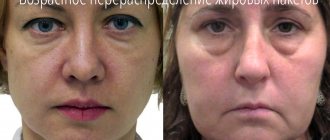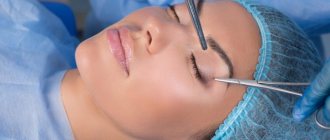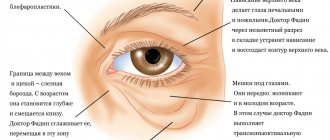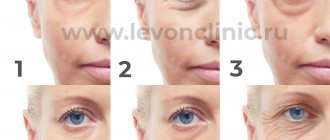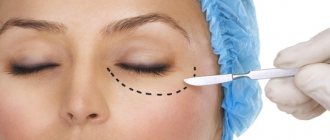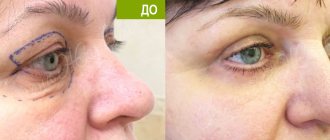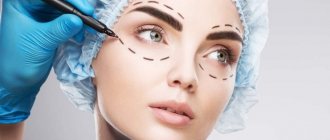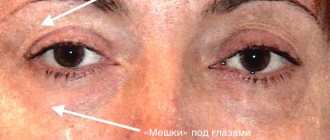- home
- Blepharoplasty
- Repeated blepharoplasty (eyelid surgery) in a clinic in Moscow
Repeated eyelid blepharoplasty is an operation to eliminate most of the aesthetic imperfections of the lower and upper eyelids. The need for repeat blepharoplasty also arises in the following cases:
- manifestations of postoperative complications
- aesthetic effects of the operation that do not satisfy the patient;
- Eyelid surgery cannot guarantee lifelong results. After 10-15 years, repeat blepharoplasty is performed;
- the presence of serious congenital deformities cannot be corrected by a single operation.
Correction of upper eyelid deformity after previous blepharoplasty.
Correction of the shape of the upper eyelid using lipofilling after previously unsuccessful blepharoplasty.
We do not add that from another surgeon, since in principle we do not perform eyelid surgery without immediate volumetric rejuvenation. Repeated eyelid blepharoplasty is a plastic surgery that allows you to rejuvenate or perform other aesthetic correction of the eyelids. Repeated blepharoplasty can be performed several times throughout life. The need for it usually appears with noticeable age-related changes or due to the manifestation of negative consequences from a previous operation.
Indications for revision blepharoplasty:
· if the patient has complications after the first operation, repeat blepharoplasty can eliminate it;
· the appearance of visual age-related changes after previously performed eyelid surgery, successfully performed six to nine years ago.
Why do age-related changes appear again after successful blepharoplasty?
Sometimes, after a certain period of time (usually 6 to 7 years), age takes its toll again. Even the most qualified and talented plastic surgeon is not able to stop the aging process and to maintain a young, attractive image, repeated use of the scalpel is necessary.
The patient underwent repeated blepharoplasty of the upper eyelid and lipofilling after previously performed eyelid surgery, which did not satisfy her.
Go to photo gallery
It is important to consider one more point. Plastic surgery does not stand still. It is developing very actively, new technologies, methods and materials are appearing. For example, the patient was not satisfied with the result of plastic surgery, which was performed several years ago. At that time, now outdated methods were used. In this case, repeated blepharoplasty in a modern modification can provide a much better aesthetic result. So, before, blepharoplasty involved radical excision of skin and fatty hernias. Whereas, at the moment, experts strive to preserve and replace fatty tissue in the periorbital region as much as possible. This is important because fat cells are responsible for youth and skin turgor.
Just five to seven years ago, unsuccessfully performed blepharoplasty could provoke sunken eyes, skeletonization, rounding of the eyelid, as well as the appearance of other problems. Now these risks are practically reduced to zero. All this became possible thanks to modern eyelid rejuvenation techniques. Today we harmoniously combine conservative tissue excision and lipofilling. Repeated blepharoplasty can correct the negative results of primary eyelid surgery, as well as significantly IMPROVE its aesthetic result.
Treatment of ectropion
To relieve the symptoms of dryness, irritation, pain and burning in the eye, despite lacrimation when the lower eyelid is everted, drugs from a series of moisturizers are used. This can be either a drop form (Oftagel, Oftolik, Optiv, Artelak, etc.) or a gel form (Vidisik, Korneregel).
If there are signs of inflammation, the doctor may prescribe a broad-spectrum antibiotic on an ointment basis: Floxal, erythromycin or tetracycline eye ointment.
| The main treatment method for ectropion is surgery. |
In cases where the cause of the pathological condition is paralysis of the facial nerve, surgical intervention is postponed for up to six months, since the functions of the nerve fibers can be restored under the influence of neurological treatment.
In other cases, the timing, methods and scope of the operation are determined by the doctor: an ophthalmologist or a plastic surgeon.
The technique and course of the intervention are determined by the cause and the associated mechanism of development of eyelid eversion. The most complex, requiring an extraordinary approach and high skill of the surgeon, are cicatricial and post-burn deformities.
Complications during blepharoplasty and methods for their correction
Repeated blepharoplasty - lipofilling of the upper eyelid was performed in order to recreate the mendala-shaped eye shape lost after blepharoplasty.
An unsuccessful surgical intervention entails disappointment and dissatisfaction for the patient. Negative aesthetic results and varying degrees of complications of blepharoplasty completely negate the original goal of rejuvenating eyelid surgery. The problems that arise after unsuccessful lower and upper blepharoplasty differ radically.
Complications after upper eyelid blepharoplasty
When performing upper eyelid surgery, the surgeon makes an incision at the level of the skin fold of the upper eyelid. Thus, to hide the scar in the natural crease of the eyelid. What is important is that she remains invisible to the gaze of others. The operation involves excision of excess fat on the upper eyelid, straightening and removal of fatty hernias. Among the most common complications of upper eyelid blepharoplasty, experts note:
- Excessive excision of skin. In most patients, the skin stretches spontaneously after a short period of time. In some cases, the patient is prescribed injections of a special drug that provokes stretching;
- Insufficient skin excision. In this case, there is no way to do without a repeat operation to remove excess skin tissue;
- Excessive removal of fatty tissue (so-called fatty hernias). The error entails a complication in the form of skeletonization of the upper eyelids. The deficiency can be corrected using the lipofilling method.
Complications after lower eyelid blepharoplasty
A complication in this case is excessive removal of fatty tissue (hernias) during the first blepharoplasty.
Ptosis (the lower eyelid is excessively taut downwards). This complication of lower eyelid blepharoplasty occurs due to excessive removal of skin under the eyes. The correction can be carried out in two ways. The surgical method involves performing canthopexy (its goal is to strengthen the outer edges of the lower eyelids). To improve the aesthetic effect, our specialists usually complement this operation with lipofilling of the outer corners of the eyes, which creates a supportive cushion. The second method is medicinal, when the skin is stretched using special drugs. Elimination of the defect using medications. Treatment can begin no earlier than 6 months after unsuccessful blepharoplasty.
Immediately after surgery:
You may feel a slight painful sensation, reminiscent of a burning sensation in the eyelids under the rays of the scorching sun. During this period (when the effect of the anesthetic wears off), you lie on your back for 2 hours with ice packs on your eyelids, which eliminates pain and prevents the development of bruises. If necessary, pain medications may be administered, which is usually not required, but can be done at the request of the patient.
After the operation, the surgeon will examine you and give you the necessary recommendations.
Do not remove the gauze bandages placed on your eyelids after surgery yourself.
Let us illustrate the progress and result of repeated eyelid blepharoplasty using a specific example.
A patient contacted our specialist. Previously, she had undergone plastic surgery of the upper and lower eyelids in another clinic. The desire to perform repeat blepharoplasty is caused by the fact that the result was not pleasant. There is no satisfaction with the results of plastic surgery, there is depression.
The diagnostics carried out allowed us to identify a number of problems.
Upper eyelid problems:
Correction of failed upper eyelid blepharoplasty
- Skeletonization caused by the removal of excessive amounts of fat;
- Unnaturally high location of the upper eyelid fold. In other words, A-deformation of the shape of the upper eyelid;
- Excess skin;
- The presence of visually noticeable scar tissue formed at the site of the incisions.
Lower eyelid problems:
- The tear trough is not corrected;
- Excess skin;
- Ptosis of the lower eyelid, the outer corners of the eyes are oriented downwards;
- The lower eyelid is lowered below an aesthetically correct level;
- There are visually noticeable changes in scar tissue.
To eliminate the above shortcomings, the following steps were taken:
- Repeated blepharoplasty of the upper eyelid, during which the fold of the eyelid was given the correct anatomical position;
- Lipofilling of the upper eyelid. The goal is to correct skeletonization and create the correct volume;
- Canthopexy of the lower eyelid. The goal is to lift and fix the outer corners of the eyes;
- Lipofilling of the lower eyelid. The goal is to rejuvenate the skin under the eyes and form an auxiliary support for the lateral corner of the eye.
The result of the measures taken: correction of all complications of blepharoplasty that arose after the initial unsuccessful eyelid surgery.
Symptoms of eyelid inversion
One of the most characteristic symptoms of ectropion is increased lacrimation (the medical term is “epiphora”). Normally, the tear fluid produced by special glands (and also, partly, by the lacrimal glands of the conjunctiva) serves to cleanse small particles, moisturize and lubricate the outer surface of the eye, primarily the cornea, which prevents it from drying out when exposed to oxygen in the air. Removal and drainage of used tear fluid is carried out through special tubules located on the conjunctiva (i.e. on the inner surfaces of the eyelids) - the so-called. "tear points" Almost the entire volume of lacrimal substance is thus excreted through a special duct into the nasal mucosa - in other words, it enters the nose.
But with ectropion, when the above-described drainage tract is grossly destroyed, the lacrimal fluid cannot naturally enter the lacrimal openings. Accumulating in the gap formed between the eye and the eyelid, at a certain volume it begins to overflow.
It should be emphasized that with the gradual formation of the organs of vision, evolution “had” to solve two opposing problems: drying out and souring of tissues due to constant excessive wetting. That is why the composition of tears is balanced in such a way that it contains not only purely liquid, moisturizing components, but also a certain mucous “lubricant” that maintains the moisture balance necessary for the outer eye membranes. With eversion of the eyelid, such balance is impossible; the lower part of the cornea and sclera dries out without the constant washing movement of the blinking eyelid, the lacrimal glands try to compensate for this and reflexively increase the secretion of fluid.
The inverted conjunctiva and the outer skin of the eyelid, on the contrary, are constantly in a stream of flowing tears, and in a heterogeneous stream: some areas dry out, others get wet. The result is a feeling of discomfort, itching, a foreign body (the most eye-specific reactions to any problem), as well as a corresponding urge, sometimes irresistible or realized unconsciously, to rub the eye. As a result, the dermis and mucous membrane of the lower eyelid quickly become inflamed.
Externally, this is manifested by redness, swelling, and the characteristic appearance of “sick meat.” Obviously, under such conditions, a direct path opens for the penetration of all kinds of pathogenic microorganisms (viruses, bacteria, fungi, parasites). With such an invasion, the pathology easily acquires an acute purulent character and can spread to adjacent ocular tissues, sometimes leading to very serious complications and consequences, including panophthalmitis (total inflammation of the eyeball) and the initiation of atrophic processes in the retina and optic nerve, resulting in blindness.
The cost of repeated blepharoplasty at the Doctor Grishkyan plastic surgery clinic in Moscow.
Blepharoplasty (eyelid surgery) cost of surgery
| Operation name | Cost in rubles |
| Upper eyelid surgery | 160000 |
| Lower eyelid surgery | 160000 |
| Blepharoplasty of the upper and lower eyelids | 250000 |
| Volume plastic surgery of the upper eyelids (upper eyelid surgery + lipofilling) | 180000 |
| Volume plastic surgery of the lower eyelids (Lower eyelid surgery + lipofilling) | 180000 |
| Transconjunctival blepharoplasty of the lower eyelids (author's technique) | 180000 |
| Repeated blepharoplasty of the upper eyelids, correction of complications after eyelid surgery by another surgeon | 210 000 |
| Repeated lower eyelid blepharoplasty, correction of complications after eyelid surgery by another surgeon | 210 000 |
How to quickly eliminate bruises and swelling?
In this article, we have compiled a list of important tips from plastic surgeons that will help you quickly eliminate surgery-related side effects such as swelling and bruising:
- Try to keep your head elevated while you sleep for the first few days after surgery. This will improve the outflow of blood and lymph from the operation area, prevent stagnation and accumulation of fluid and reduce swelling of the eyelids after blepharoplasty;
- Place cold compresses on your eyes for the first 2-3 days. Cold helps blood vessels constrict and prevents the increase in hematomas and swelling;
- Refrain from blinking too often, as it increases swelling;
- To prevent excessive blinking, avoid activities that cause the surface of your eyes to dry out quickly. Such activities include reading, watching TV, working and playing on the computer, wearing contact lenses, etc.;
- Wear sunglasses that will protect your eyes and eyelids not only from the sun's ultraviolet radiation, but also from wind and dust. This is necessary because after blepharoplasty, the eyes and skin of the eyelids are especially vulnerable to the aggressive effects of environmental factors;
- Avoid activities that increase blood flow to the eye area. This includes: pull-ups, push-ups and other intense sports training, as well as crying, taking a hot shower, visiting a bathhouse and sauna).
- During the rehabilitation period, drink less alcohol and caffeinated drinks. They cause fluid retention in tissues and increase blood flow, which means they provoke an increase in edema.
Those who follow these recommendations after blepharoplasty should not be alarmed by swelling and bruising.
